In today’s market, having a skilled graphic designer is key for any business wanting to stand out. They create designs that look great and connect with people. A good design can make a company unique, leaving a lasting impression on potential customers.
This article will look at the different parts of graphic design. It will show how important it is for branding and the look of a business in the UK.
Understanding the Role of a Graphic Designer
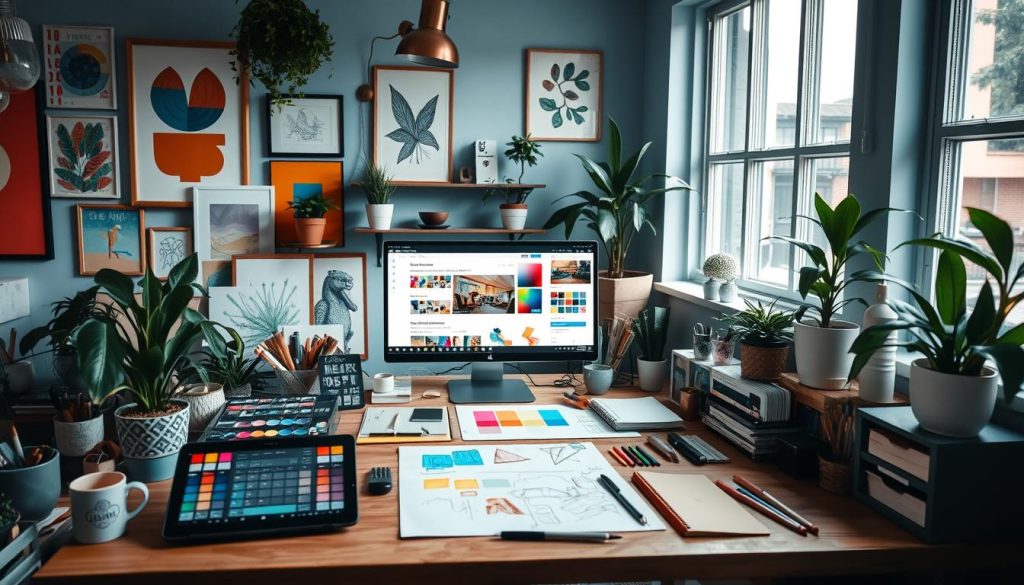
The role of a graphic designer is complex and crucial in the creative services field. They create visual concepts that share ideas, feelings, and messages with an audience. Their work includes making logos, branding, and designing for print and digital media.
Graphic designers turn communication needs into visual solutions. They need to understand what clients want. Working together with clients is important to get feedback and make sure the designs meet the goals.
Designers use both old and new tools to make art that speaks to people. They need technical skills and creativity to think outside the box and come up with new ideas. By keeping up with trends and technology, they stay relevant in a fast-changing world.
Benefits of Hiring a Professional Graphic Designer
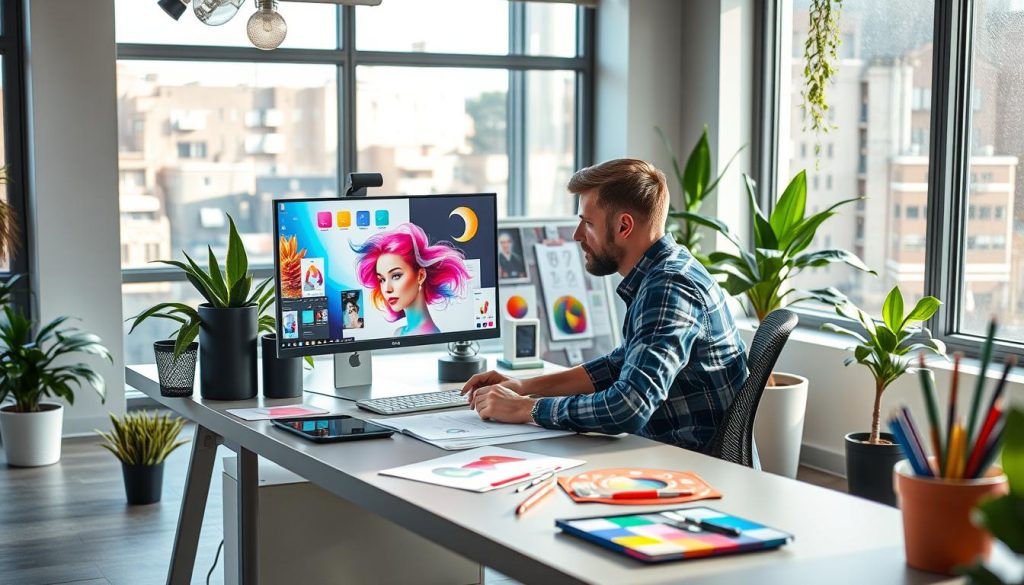
Working with a professional graphic designer can really help businesses build a strong brand and work more efficiently. These experts have a lot of knowledge and creativity. They make brands look better and help businesses focus on what they do best.
Enhancing Brand Identity
A professional graphic designer is key to shaping a company’s brand identity. They create logos, colour schemes, and typography that speak to the target audience. This makes sure the brand’s message gets across, building recognition and loyalty with customers.
Saving Time and Resources
When businesses hire a skilled graphic designer, they save a lot of time. By handing over design tasks, they can focus on what’s really important. This makes work flow better and ensures designs are professional and creative.
Key Skills Required for Successful Graphic Designers
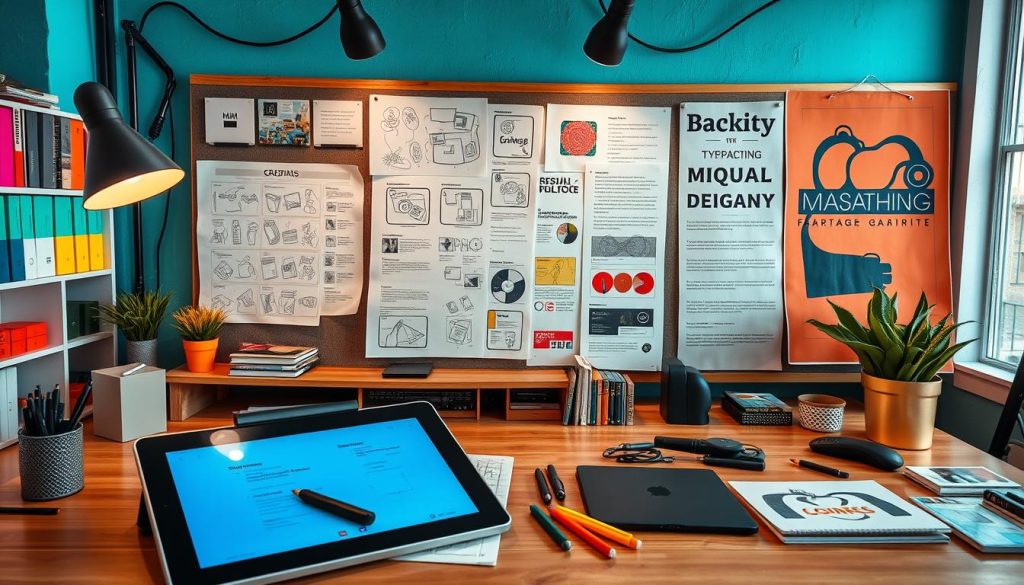
Graphic designers need both artistic vision and technical skills to succeed. They must blend creativity with the ability to use design software well. This mix helps them make designs that grab attention and get the message across.
Creativity and innovation are key. They help designers come up with fresh ideas that speak to people. Being able to think differently is crucial for making a brand stand out.
Creativity and Innovation
Thinking creatively is at the heart of graphic design. It’s what turns ordinary designs into something special. By being innovative, designers can make a brand pop in a busy market.
Technical Proficiency in Design Software
Knowing how to use design software is also crucial. Tools like Adobe Creative Suite and Sketch are vital for graphic designers. Being skilled in these tools lets designers bring their ideas to life.
For those starting out, learning design software is a must. It boosts their artistic skills and makes them more versatile.
Popular Design Services Offered by Graphic Designers
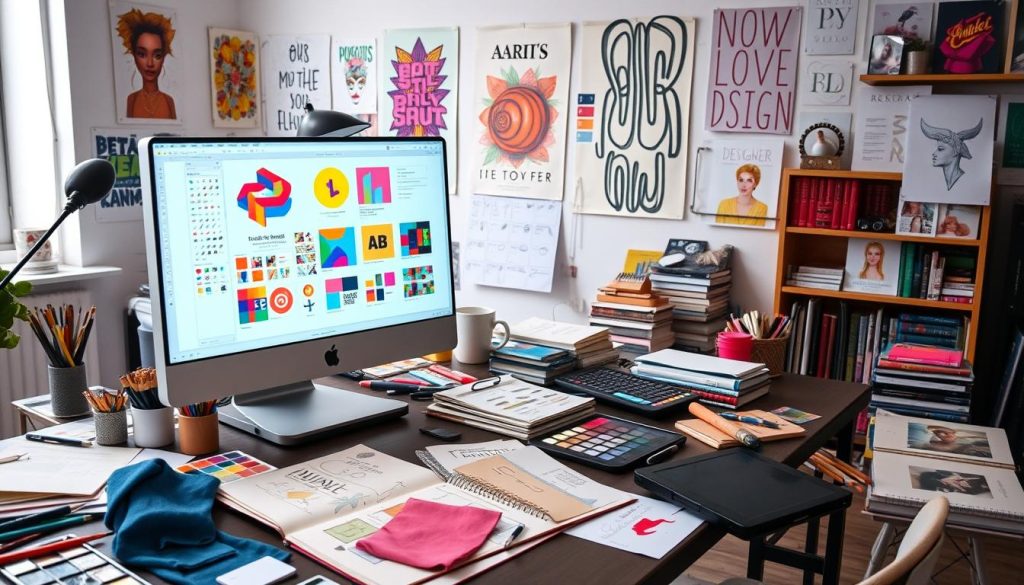
Graphic designers provide many services for both businesses and individuals. These services help make a brand stand out and connect better with its audience. The main services include logo and brand design, social media graphics, and web design and development.
Logo and Brand Design
Creating a logo is key to a brand’s identity. A good logo is easy to spot and shows what the business stands for. It helps the brand stand out, build trust, and keep customers loyal.
Social Media Graphics
Social media graphics are vital today for grabbing attention on sites like Instagram and Facebook. Designers make content that gets people talking, raises brand awareness, and gets followers to interact with the brand.
Web Design and Development
Web development is key for a smooth online experience. A professional website made by a skilled designer boosts a company’s online image. It includes making layouts look good and making sure the site works well to improve user experience and increase sales.
How to Choose the Right Graphic Designer for Your Business
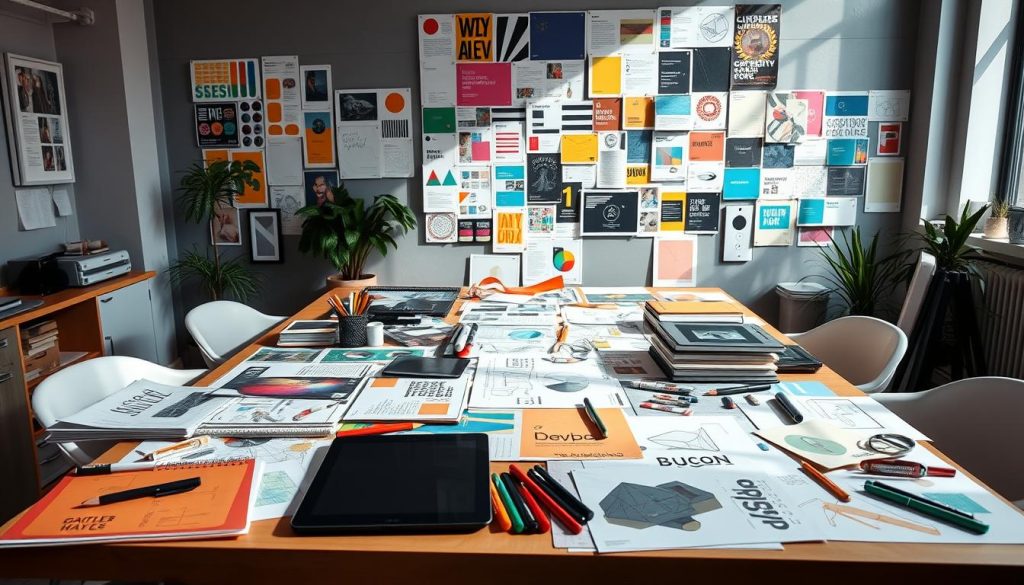
Finding the right graphic designer can feel overwhelming with so many choices. It’s key to look at several things to make sure you pick someone who fits your needs. Start by checking their portfolio and reading what past clients say about them.
Portfolio Assessment
A portfolio is like a designer’s best work showcase. Look at it to see:
- The variety of projects they’ve done
- If their quality and style are consistent
- If their work fits your industry and what you need
- How creative and new their ideas are
Going through a designer’s portfolio deeply helps you see if they can bring your brand to life.
Understanding Client Testimonials
Client testimonials are very important when picking a graphic designer. They share real stories from past clients about the designer’s trustworthiness, how they communicate, and if they’re happy with the final product. Look for:
- Details on how they managed project timelines
- How they solved problems
- How they worked with clients together
Reading these testimonials helps you understand how a designer will work with you and if they meet your expectations.
Freelance Graphic Designer vs. Design Agency: Pros and Cons
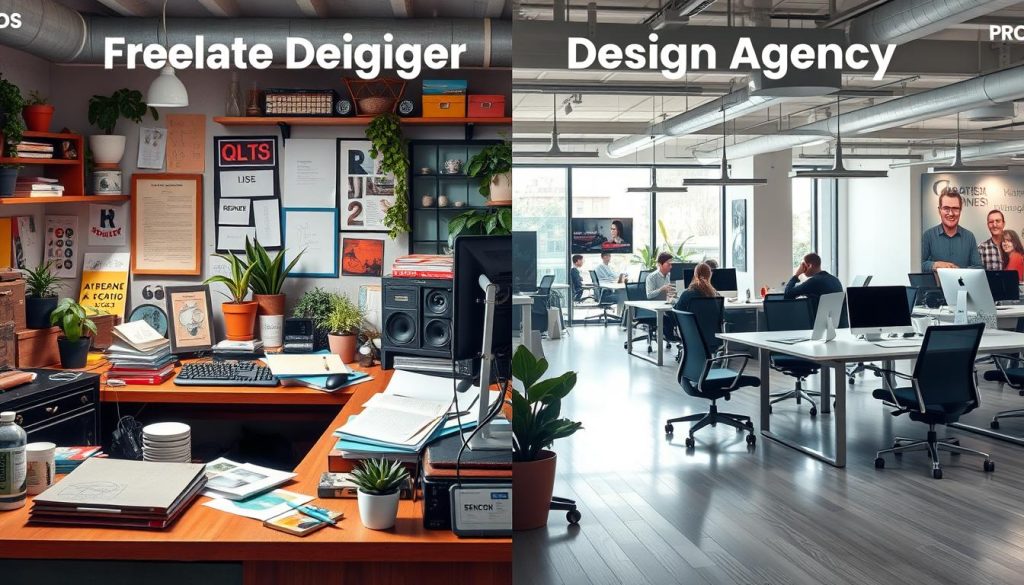
Choosing between a freelance graphic designer and a design agency has its pros and cons. Freelancers are often cheaper because they don’t have high overhead costs. They can tailor their style to fit what you need.
Design agencies are great for big projects. They have many designers with different skills. This means they can handle complex designs well. Clients get regular updates and support, keeping projects on schedule.
- Freelance Pros:
- Cost-effective solutions.
- Personalised service tailored to individual requirements.
- More flexibility in terms of creativity.
- Freelance Cons:
- Limited capacity for larger projects.
- Possibility of inconsistent outputs if working solo.
- Unpredictable availability.
- Agency Pros:
- Access to a wider range of skills and expertise.
- Capacity to handle large-scale projects efficiently.
- Consistent quality control with multiple team members involved.
- Agency Cons:
- Higher costs due to overhead and team structure.
- Less personal interaction compared to freelancers.
- Longer turnaround times for creative processes.
Understanding Graphic Design Pricing Structures
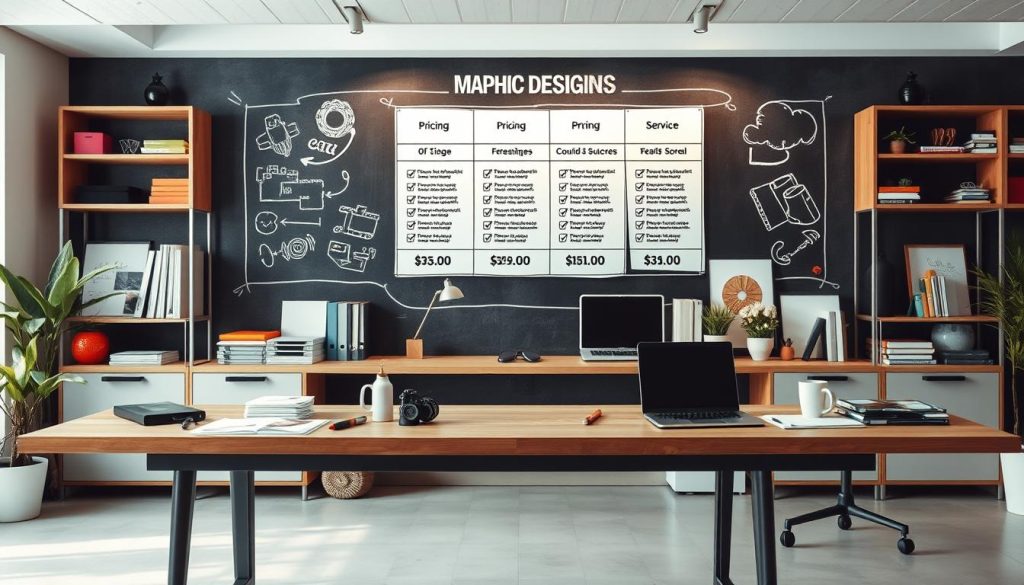
The graphic design world has different ways to charge for services. Knowing the difference between hourly rates and project pricing helps clients plan their budgets better. Each method suits different needs, based on the project’s size and complexity.
Hourly Rates vs. Project Pricing
It’s key to understand the difference between hourly and project fees when looking at design costs. Hourly rates mean paying for the time spent on a job, ideal for small or vague tasks. Project pricing, however, gives a total cost for the whole job, considering its size and complexity. This approach is great for big projects, offering clients a clear total cost from the start.
Factors Influencing Design Costs
Many things affect design costs, so it’s important for clients to know them before hiring a designer. Key factors include:
- Project complexity: Complex designs need more time and expertise, leading to higher costs.
- Designer experience: Experienced designers charge more because of their advanced skills and good reputation.
- Timeline requirements: Rushed projects might cost extra to meet tight deadlines.
Establishing Your Graphic Designer Business

Starting a graphic design business needs careful planning and action. A strong business model is key to success. First, pick the area you want to focus on, like digital design, print, or branding. Knowing your market helps shape your services to attract clients.
Branding is vital to stand out. Create a brand that shows off your design style and speaks to your audience. This means having a catchy logo, a professional website, and consistent messages everywhere.
Once you have your plan, get the legal stuff sorted. You’ll need licenses and permits based on where you are. Being legal shows you’re serious and builds trust with clients.
Setting your prices right is important. Look at what others charge to find a fair rate for your skills. This way, you can offer great value without undercutting yourself.
- Define your niche in the design market.
- Create a unique branding strategy.
- Obtain necessary licenses.
- Research and implement effective pricing strategies.
Starting a graphic design business involves many key steps, from planning to branding. Focus on these areas to increase your chances of success.
Branding and Marketing Strategies for Graphic Designers
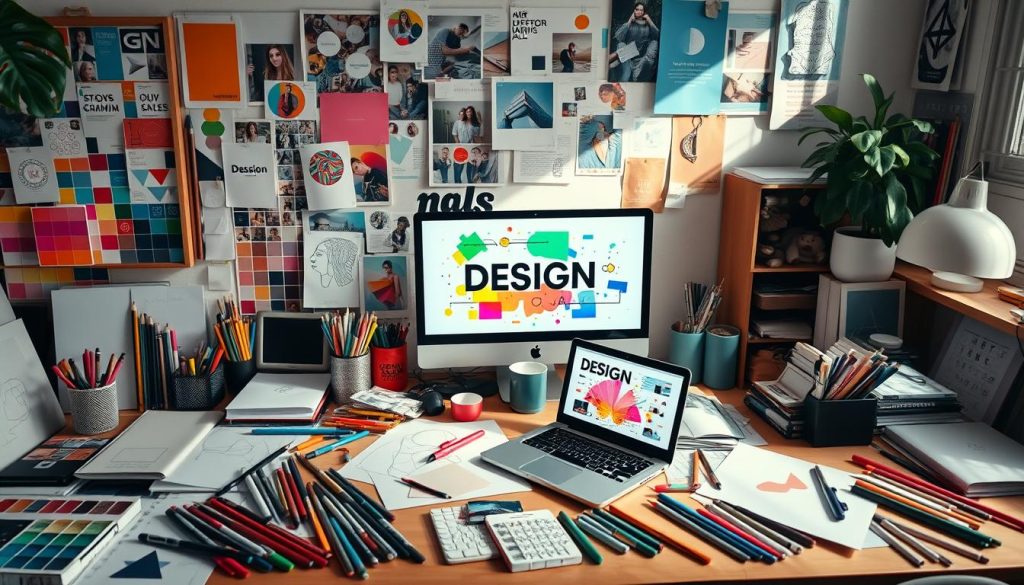
Branding and marketing are key to standing out in the graphic design world. Using social media is a great way to get noticed, connect with clients, and build a brand. It lets designers share their work and reach more people easily.
Utilising Social Media Platforms
Social media is a must-have for marketing in graphic design. It helps designers to:
- Share their portfolio and recent projects
- Engage with followers through comments and messages
- Participate in design communities and discussions
- Stay updated with industry trends and competitor insights
By using platforms like Instagram, LinkedIn, and Pinterest, graphic designers can boost their online presence. This is key to drawing in new clients.
Networking with Other Professionals
Networking is vital for a graphic designer’s success. It opens doors to valuable collaborations and referrals. Good networking strategies include:
- Attending industry events and workshops
- Joining online forums and communities dedicated to design
- Collaborating on projects with fellow creatives
- Connecting with potential clients and partners on social media
The Importance of Portfolio in Graphic Design Business
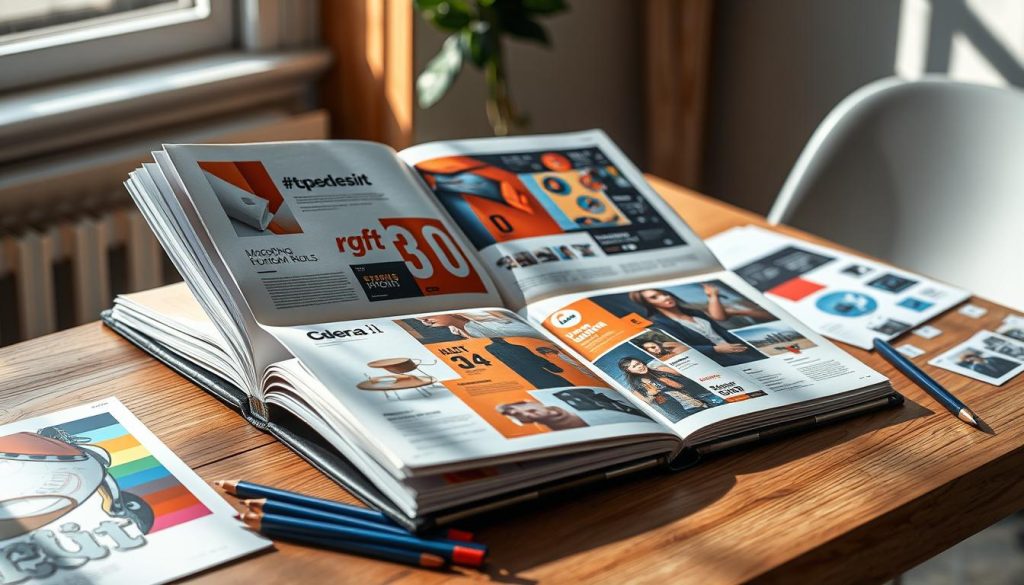
A well-curated graphic design portfolio is key in the design world. It shows off your work and proves your skills, versatility, and creativity to potential clients. Keeping your portfolio up to date shows you’re professional and dedicated. This makes a good first impression and helps you get new clients.
When building a graphic design portfolio, think about these tips:
- Select a Range of Work: Include a mix of projects that show off different skills and styles.
- High-Quality Images: Make sure all images are clear and high resolution for best effect.
- Case Studies: Add context and explain the process behind key projects to show your approach.
- Personal Projects: Include your passion projects to show your creativity and drive.
Adding these elements to your portfolio helps you connect with potential clients. Showing your work well can open up new opportunities and lead to successful collaborations.
Common Challenges Faced by Graphic Designers

Graphic designers face many challenges that can impact their work and client satisfaction. Two big issues are managing what clients expect and keeping up with design trends. Overcoming these challenges can make their work better and their projects more successful.
Client Expectations and Communication
One big challenge is meeting client expectations. Good communication with clients is key to a successful project. Designers must make sure they understand the brief, get feedback, and match the client’s vision.
Not understanding clients can lead to extra work and delays. So, it’s important to be clear and open from the start.
Staying Updated with Design Trends
Keeping up with design trends is another big challenge. The world of design changes fast, and not keeping up can make designs look old or less effective. By staying current with trends, designers can keep their work fresh and make sure it looks modern and works well.
The Role of Graphic Designers in Digital Marketing

Graphic designers are key in making visual content that boosts brand visibility and engagement. With more online content, eye-catching ads are vital for marketing success. They create visuals that speak to the audience and increase interaction, showing their worth.
Graphic designers focus on making different types of ads, such as:
- Social media graphics that match the brand’s look
- Infographics that make complex info easy to understand
- Banner ads that grab attention with their design
Having consistent visual content across platforms helps brands stay strong and easy to recognise. This keeps customers loyal and makes the message clear. As digital marketing grows, so does the need for talented graphic designers. Companies see how crucial visuals are in their ads.
Networking and Building Relationships in the Graphic Design Industry

Networking is key in the graphic design world. It helps designers meet others and find new chances. Going to design events like conferences and workshops is a great way to connect with peers and potential clients. These meetings can lead to exciting projects that help designers grow.
Being part of online design communities also boosts connections. Sites like LinkedIn, Behance, and Dribbble are perfect for graphic designers. They let designers share their work and talk about the latest trends.
Having good industry relationships does more than just lead to work. A strong network means getting referrals and recommendations. This can help designers find new clients. By keeping up with their connections, designers can get more business through word of mouth. This is a powerful way to promote their work.
Effective Communication Skills for Graphic Designers
Good communication is key for graphic designers. It helps them connect with clients and get the project right. They must listen carefully to what clients want to make sure they meet their needs. This clear communication avoids misunderstandings and strengthens relationships with clients.
Designers also need to change how they talk to different people in a project. They might explain complex designs to clients or work with marketing teams. Being able to adjust their language makes them more effective. This leads to smoother projects and better results.
Good communication is more than just talking. It lays the groundwork for lasting relationships in the industry. As designers work with many clients and partners, their communication skills build trust. This trust helps them become known as professionals. So, focusing on communication is vital for success in graphic design.
















